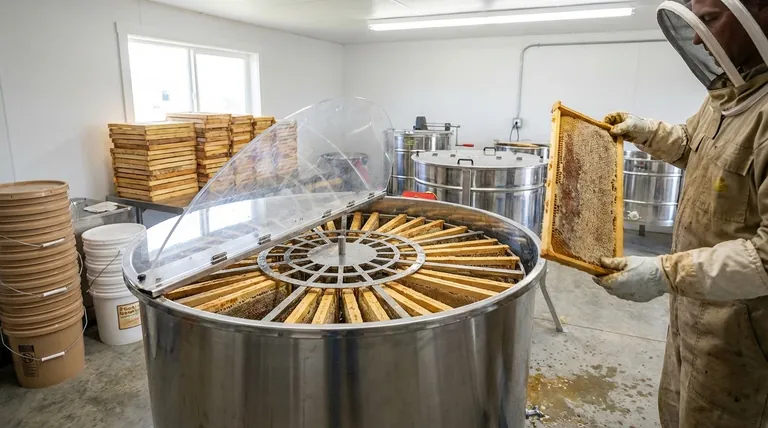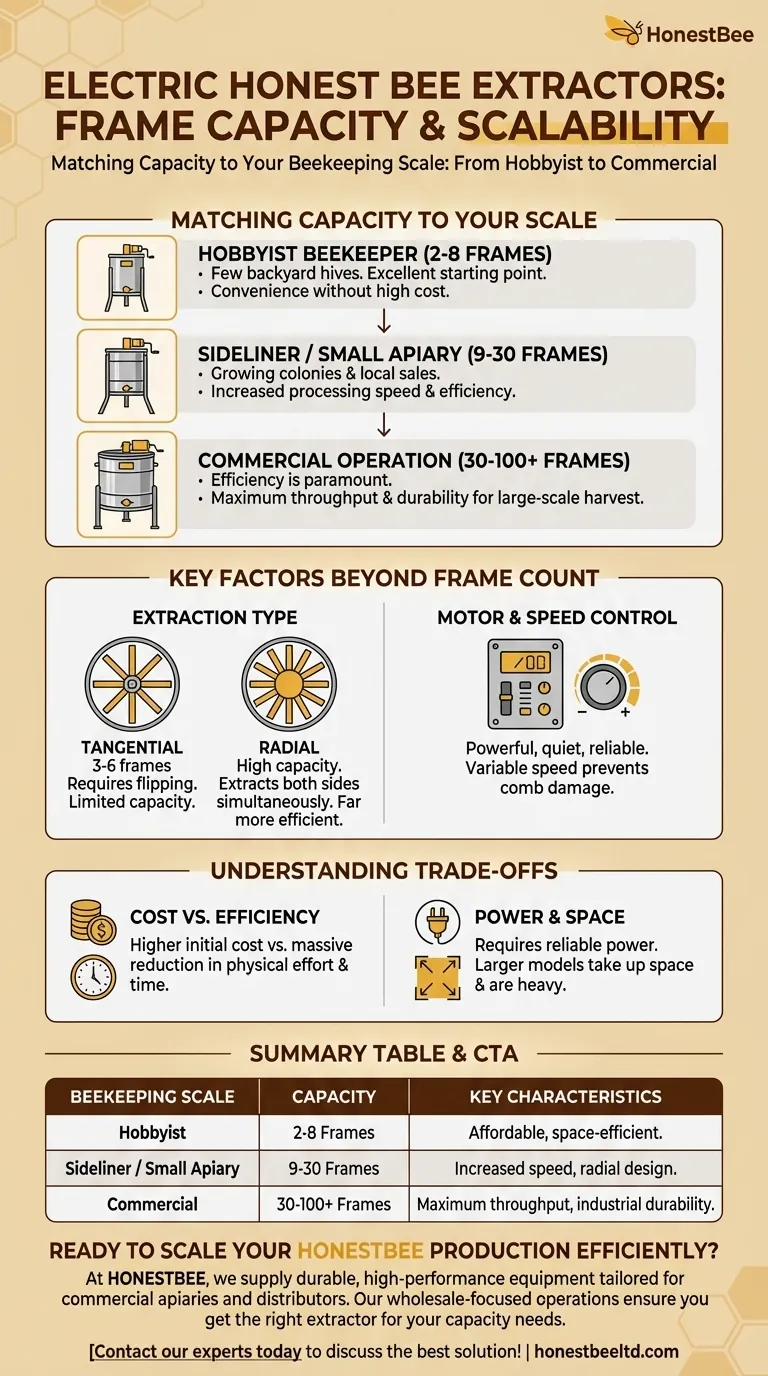The short answer is electric honey extractors have an exceptionally wide capacity range, handling anywhere from 2 to over 100 frames at a time. This vast difference is because they are designed to serve everyone from the small-scale hobbyist to the large commercial beekeeper. The specific model and its design (radial or tangential) ultimately determine its precise frame count.
The number of frames an electric extractor can hold is less a single specification and more a reflection of its intended use. Understanding your operational scale—from a few backyard hives to a commercial apiary—is the key to choosing a capacity that enhances efficiency rather than creating a bottleneck.

Matching Capacity to Your Beekeeping Scale
The "right" capacity is entirely dependent on the size of your operation. Manufacturers offer different tiers of electric extractors specifically designed to meet the needs of beekeepers at every level.
For the Hobbyist Beekeeper (2-8 Frames)
For beekeepers with just a few hives, smaller electric models are an excellent starting point. These units offer the convenience and reduced physical labor of motorized extraction without the high cost or large footprint of commercial equipment. They are a significant step up from 2-4 frame manual extractors.
For the Sideliner or Small Apiary (9-30 Frames)
This mid-range capacity is ideal for beekeepers who manage a growing number of colonies and perhaps sell honey locally. These extractors, often radial in design, dramatically increase processing speed and reduce the demanding work of uncapping and extracting, allowing you to process dozens of frames efficiently.
For Commercial Operations (30-100+ Frames)
At the commercial level, efficiency is paramount. Large-capacity radial extractors are the industry standard, built for maximum throughput and durability. These machines are designed to run for hours, extracting honey from a hundred or more frames in a single load to keep a large-scale harvesting workflow moving.
Key Factors Beyond Frame Count
While capacity is a headline feature, other design elements play a crucial role in an extractor's performance and suitability.
Extraction Type: Radial vs. Tangential
The extractor's design directly impacts its capacity. Tangential extractors hold frames like spokes in a wheel with one side facing out, requiring you to flip them halfway through. This limits their capacity, typically to between 3 and 6 frames.
Radial extractors place frames like the rays of the sun, allowing honey to be extracted from both sides simultaneously due to centrifugal force. This design is far more efficient and allows for the very high capacities seen in commercial models.
Motor and Speed Control
The motor is the heart of an electric extractor. Modern units feature powerful, quiet, and reliable motors designed for durability. More importantly, they offer variable speed control. This allows you to start the spin slowly to avoid damaging delicate new comb before ramping up to full speed for efficient extraction.
Understanding the Trade-offs
Choosing an electric extractor involves balancing clear benefits with practical considerations.
Cost vs. Efficiency
The primary trade-off is cost. Electric extractors are significantly more expensive than manual ones. However, the investment pays off through a massive reduction in physical effort and time spent in the honey house, a crucial factor for anyone with more than a few hives.
Power and Space Requirements
Unlike a manual extractor, an electric model requires a reliable power source. You must ensure you have access to a properly grounded outlet in your workspace. Furthermore, larger capacity models are heavy and take up considerable floor space, requiring a stable, level surface for safe operation.
Safety and Maintenance
The moving parts of an electric extractor pose a safety risk. Never overload the machine, ensure it is stable before starting, and keep hands, hair, and clothing away from the basket. Regular checks of electrical components are essential for safe, long-term use.
Making the Right Choice for Your Goal
Your ideal extractor should align with your current needs while leaving room for future growth.
- If your primary focus is a few backyard hives: A small electric model (2-8 frames) offers a significant upgrade in convenience over manual extraction without a major investment.
- If you are growing your apiary and selling honey locally: A mid-sized radial extractor (9-30 frames) will dramatically increase your processing speed and reduce labor.
- If you are running a commercial beekeeping operation: Your decision should center on large-capacity radial extractors (30-100+ frames) where throughput and durability are paramount.
Ultimately, choosing the right capacity is about investing in the level of efficiency your beekeeping operation truly requires.
Summary Table:
| Beekeeping Scale | Recommended Frame Capacity | Key Characteristics |
|---|---|---|
| Hobbyist | 2 - 8 Frames | Affordable, space-efficient, ideal for a few hives. |
| Sideliner / Small Apiary | 9 - 30 Frames | Increased speed, radial design, for local honey sales. |
| Commercial Operation | 30 - 100+ Frames | Maximum throughput, industrial durability, radial design. |
Ready to scale your honey production efficiently? The right electric extractor is a game-changer for your harvest. At HONESTBEE, we supply durable, high-performance beekeeping equipment and supplies tailored for commercial apiaries and distributors. Our wholesale-focused operations ensure you get the right extractor for your capacity needs at a competitive price. Contact our experts today to discuss the best solution for your operation!
Visual Guide

Related Products
- HONESTBEE 72 Frame Industrial Electric Honey Extractor for Beekeeping
- 40 Frame Commercial Electric Honey Extractor for Beekeeping
- Commercial 48-Frame Stainless Steel Honey Extractor
- Commercial Electric 12 Frame Honey Extractor Spinner Motorized Honey Extractor
- electric honey extractor honey centrifuge 3 frame honey extractor stainless steel honey frame extractor
People Also Ask
- What are the advantages of automatic honey extractors? Scale Your Apiary with Unmatched Efficiency
- What are the two common types of honey extractors? Choose the Right Extractor for Your Apiary
- How is honey harvested from Langstroth hives? A Guide to Efficient, Comb-Preserving Extraction
- Can a manual extractor be upgraded to an electric one? Save Labor & Boost Efficiency
- What are the advantages of automated honey extractors in terms of time efficiency? Boost Your Harvest Speed



















